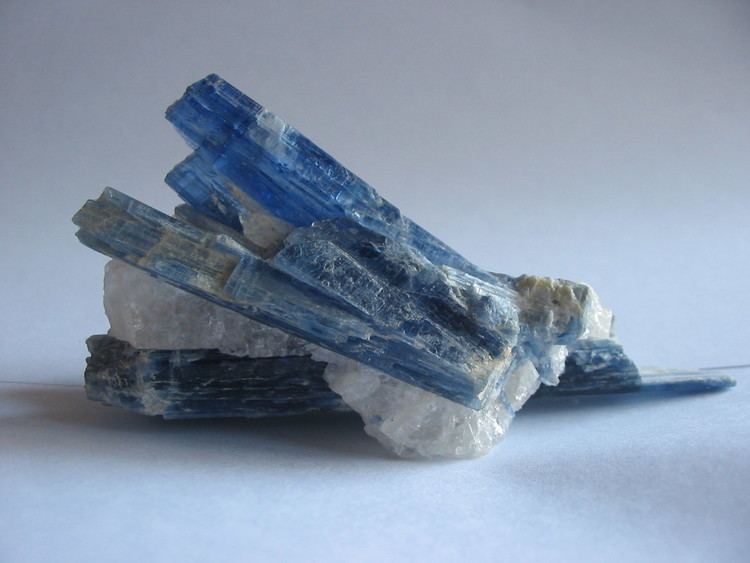Category Nesosilicate Strunz classification 9.AF.15 Space group P1 | Formula(repeating unit) Al2SiO5 Crystal system Triclinic | |
 | ||
Crystal class Pinacoidal (1)(same H-M symbol) | ||
Kyanite is a typically blue silicate mineral, commonly found in aluminium-rich metamorphic pegmatites and/or sedimentary rock. Kyanite in metamorphic rocks generally indicates pressures higher than four kilobars. Although potentially stable at lower pressure and low temperature, the activity of water is usually high enough under such conditions that it is replaced by hydrous aluminosilicates such as muscovite, pyrophyllite, or kaolinite. Kyanite is also known as disthene, rhaeticite and cyanite.
Contents
Kyanite is a member of the aluminosilicate series, which also includes the polymorph andalusite and the polymorph sillimanite. Kyanite is strongly anisotropic, in that its hardness varies depending on its crystallographic direction. In kyanite, this anisotropism can be considered an identifying characteristic.
At temperatures above 1100 °C kyanite decomposes into mullite and vitreous silica via the following reaction: 3(Al2O3·SiO2) → 3Al2O3·2SiO2 + SiO2. This transformation results in an expansion.
Its name comes from the same origin as that of the color cyan, being derived from the Ancient Greek word κύανος. This is generally rendered into English as kyanos or kuanos and means "dark blue".
Uses
Kyanite is used primarily in refractory and ceramic products, including porcelain plumbing fixtures and dishware. It is also used in electronics, electrical insulators and abrasives.
Kyanite has been used as a semiprecious gemstone, which may display cat's eye chatoyancy, though this use is limited by its anisotropism and perfect cleavage. Color varieties include recently discovered orange kyanite from Tanzania. The orange color is due to inclusion of small amounts of manganese (Mn3+) in the structure.
Kyanite is one of the index minerals that are used to estimate the temperature, depth, and pressure at which a rock undergoes metamorphism.
Occurrence
Kyanite occurs in gneiss, schist, pegmatite, and quartz veins resulting from high pressure regional metamorphism of principally pelitic rocks. It occurs as detrital grains in sedimentary rocks. It occurs associated with staurolite, andalusite, sillimanite, talc, hornblende, gedrite, mullite and corundum.
Kyanite occurs in Manhattan schist, formed under extreme pressure as a result of the two landmasses that formed supercontinent Pangaea.
